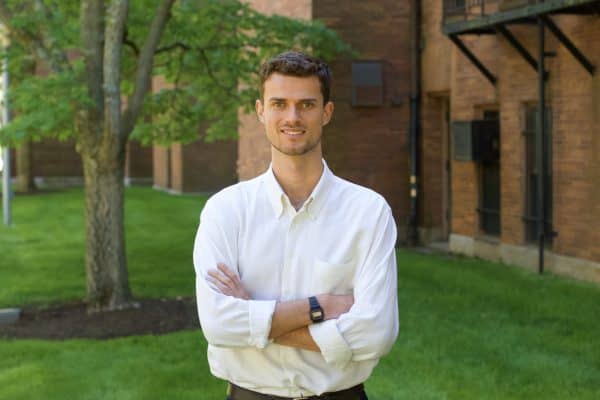Reducing carbon dioxide emissions from manufacturing and energy production (a process known as decarbonisation) isn’t just challenging — it’s slow.
Unfortunately, most organisations lack the time and resources to evaluate different pathways to reducing emissions: Assessing each potential solution can take months or years, and the risk of choosing the wrong approach and retrofitting billion-dollar facilities carries significant financial ramifications.
Paul Sizaire, a French-born civil engineer turned MIT policy researcher, is helping transform how industries plan carbon reduction. As co-founder and head of product at Sesame Sustainability, he brings years of academic research to software that’s helping industry giants like Chevron and JERA evaluate decarbonisation strategies in weeks, not months — greatly accelerating the path toward a sustainable future.
From engineering principles to systems thinking
While attending Imperial College London, Paul Sizaire immersed himself in the study of fluid dynamics (how liquids and gases flow around objects) and structural systems, which analyse how physical structures respond to forces. The perfect encapsulation of these concepts, and a technology Sizaire found himself particularly fascinated by, is offshore wind turbines, where fluid dynamics principles determine blade efficiency while structural systems ensure towers can withstand powerful ocean forces.
Sizaire saw engineering as a way to tackle climate challenges through practical innovation. But as he progressed through his studies, he soon realised the limitations of a purely technical approach.
“I realised during my time at Imperial,” Sizaire explains, “that despite how sound a technology may be from an engineering standpoint, many other factors influence its final deployment. These include their economics, the material availability, but most importantly, the policy landscape.”
This realisation sparked a mindset shift in Sizaire as he became increasingly focused on the intersection of technology and policy — two concepts that often seem at odds with each other. He pursued this new perspective at MIT’s Technology & Policy Program, where he joined the prestigious MIT Energy Initiative and research group SESAME. There, under the guidance of principal research scientist Dr. Emre Gençer, Sizaire worked on developing optimisation algorithms that could assess the costs and infrastructure needs of widespread hydrogen adoption. His work significantly contributed to a report called Harnessing Hydrogen, which was commissioned by the U.S. Department of Energy and the National Petroleum Council.
Throughout the course of this research, SESAME developed software capable of analysing the supply chains of heavy industries like cement and steel from a cost and emissions perspective. In doing so, it could provide insight into different configurations of technologies that would result in lower emissions.
It’s a goal that’s close to Sizaire’s heart: “The power of software is increasingly obvious to me,” he reflects. “Leveraging such tools as a backbone to accelerate the energy transition seems like the right mission.”
Recognising that this project had significant potential beyond research, Sizaire worked with Dr. Gençer and fellow MIT student Jim Owens to spin out Sesame Sustainability, a startup dedicated to transforming how industries approach decarbonisation planning.
Spinning out Sesame Sustainability
Sesame Sustainability takes the modeling capabilities of SESAME’s original software and turns it into an intuitive tool that companies can use to decarbonise complex supply chains.
It’s built to solve one of the energy transition’s biggest challenges: With often billion-dollar assets that have exceedingly complex operational parameters, organisations must conduct vast amounts of research before they can take any tangible action. Without an efficient way to understand which technological pathways can meaningfully reduce emissions while remaining economically viable, any major change can take months to years to implement.
By modelling both emissions and economic trade-offs across a range of technology pathways, Sesame Sustainability’s software allows organisations to run high-fidelity assessments in a matter of weeks instead of spending months to years on traditional engineering feasibility studies.
Tailor-fitting his earlier optimisation algorithms, Sizaire has powered the platform with models that clearly simulate the operation of industrial assets when powered with variable renewable electricity — ultimately optimising their capacity and deployment.
However, what proved to be a challenge was making these models usable and the data-rich results readable by non-technical stakeholders. To this end, Sizaire taught himself Figma and designed an intuitive user interface that allows users to easily interact with the underlying optimisation model, get digestible results for their specific configuration, and immediately see their potential impact on emissions and costs — successfully abstracting the complexity of energy systems without sacrificing analytical depth.
“I am particularly proud of Sesame’s user experience because we represent very complex processes in a streamlined way without compromising on granularity and detail,” Sizaire says. “It’s what we hope will be the democratisation of decarbonisation assessments.”
With clearer data and a powerful, intuitive modelling framework, Sesame Sustainability is empowering companies to align around consistent insights, efficiently plan sustainability initiatives, and move faster toward cleaner technologies. In just its first year, it raised a $2.4M seed round from investors like Flybridge and Powerhouse Ventures, attracting clients like industry leaders Chevron and JERA (one of Japan’s largest power generation companies) — both of which are already using the platform to evaluate emissions-reduction strategies across their operations.
A London-born vision with global ambition
From his studies at Imperial to leading global decarbonisation at Sesame Sustainability, Paul Sizaire has refined his vision to a specific goal: accelerating the world’s path to net zero.
His work at Sesame is going a long way toward meeting this goal. By transforming obtuse academic research into real-world insights that power practical planning, he’s helping make decarbonisation an achievable mission at a critical moment, as industrial companies face growing pressure to reduce emissions while maintaining economic viability. In reducing months of engineering studies to weeks of interactive planning, Sizaire and his team are removing one of the most persistent bottlenecks in the energy transition.
And in a climate crisis where time is as precious as the solutions themselves, his work to expedite industrial decarbonisation may prove to be just as vital as the renewable technologies these industries will eventually deploy.

